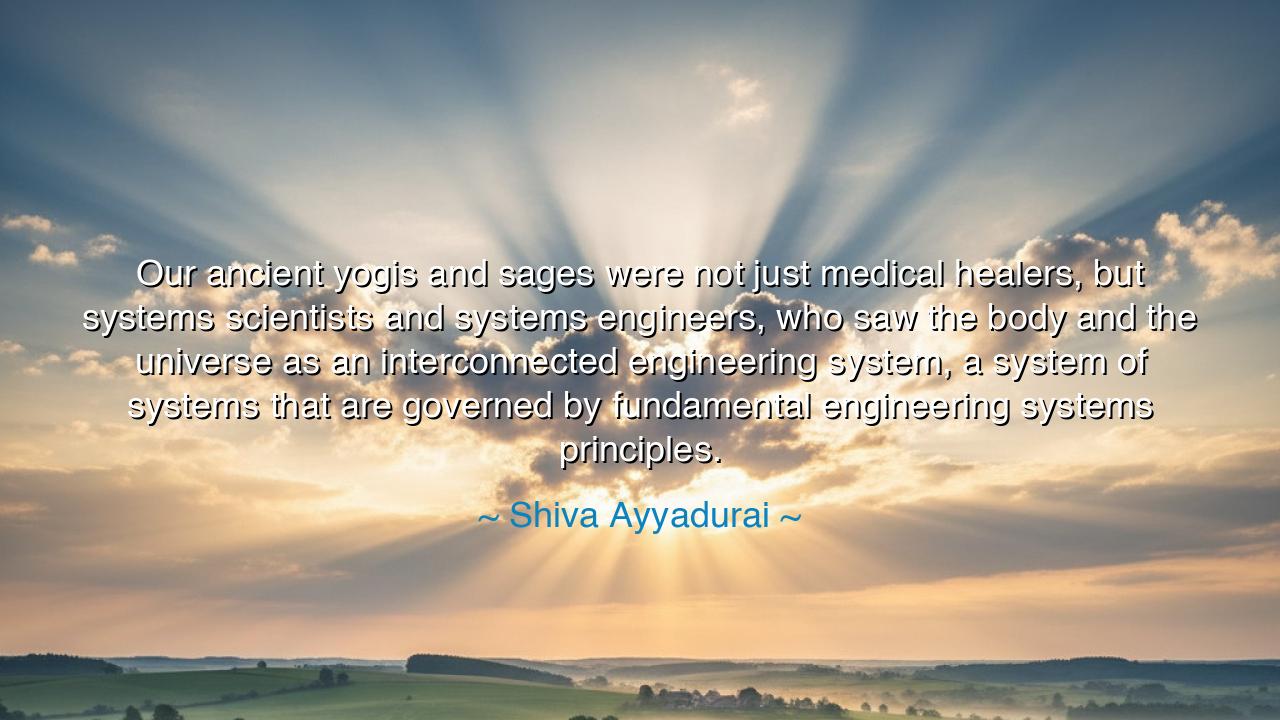
Our ancient yogis and sages were not just medical healers, but
Our ancient yogis and sages were not just medical healers, but systems scientists and systems engineers, who saw the body and the universe as an interconnected engineering system, a system of systems that are governed by fundamental engineering systems principles.






“Our ancient yogis and sages were not just medical healers, but systems scientists and systems engineers, who saw the body and the universe as an interconnected engineering system — a system of systems that are governed by fundamental engineering systems principles.”
Thus spoke Dr. Shiva Ayyadurai, a man of science and philosophy, seeking to unite the wisdom of the ancients with the language of the modern age. His words remind us that before laboratories and universities, before equations and machines, there existed those who looked inward and outward and saw the harmony between the human body and the cosmos. They were not simply mystics lost in meditation; they were engineers of consciousness, scientists of spirit, who saw in every pulse of life a pattern — an order — a law of balance.
The origin of this truth lies in the very heart of ancient India, where sages like Charaka, Sushruta, and Patanjali explored existence not with steel instruments, but with the instrument of the mind, sharpened through discipline and contemplation. The yogis did not separate medicine from philosophy, nor body from spirit. To them, healing was not the correction of one part, but the restoration of the entire system — body, breath, mind, and soul — to its natural rhythm with the universe. This, Ayyadurai reminds us, is the essence of a systems approach: to see the many as one, and the one reflected in the many.
When Dr. Ayyadurai calls these sages “systems scientists and engineers,” he bridges the ancient and the modern. In today’s world, systems engineering seeks to understand how parts interact to form a coherent whole — how feedback, balance, and flow govern complex structures. Yet millennia ago, the yogis had already discerned this truth. Through observation of the five elements — earth, water, fire, air, and ether — they saw how nature organized itself into dynamic equilibrium. They recognized homeostasis before the term existed, and understood that the health of the body was inseparable from the harmony of the environment. Thus, what we now call holistic medicine or systems biology was once known simply as Yoga — union.
Consider the ancient Ayurvedic tradition, founded upon this same principle of interconnectedness. The physician Sushruta, revered as the father of surgery, did not treat a wound merely as an injury to flesh, but as a disturbance in the network of life that bound the body together. He taught that every ailment, from the smallest fever to the gravest disease, reflected an imbalance of forces both internal and external. To heal, one must restore harmony — not by force, but through understanding the relationships among all parts. This is the same wisdom that modern systems engineers seek: to know not just the parts, but the patterns that connect them.
Dr. Ayyadurai’s words also reveal a spiritual law — that the universe itself is an engineering marvel, governed by balance and feedback, by cycles of creation and dissolution. The stars move in their orbits as surely as blood flows through veins; rivers mirror the pathways of the nervous system; the pulse of the human heart echoes the rhythm of cosmic time. The sages saw no boundary between the microcosm and the macrocosm — man and cosmos were one organism, bound by the same eternal mathematics of life. In their meditations, they found equations not on paper, but in silence; they discerned systems not with machines, but with the inner eye of wisdom.
Yet Ayyadurai’s quote carries not only reverence for the past, but a challenge to the present. He calls upon modern thinkers to reunite the analytical with the intuitive, the mechanical with the spiritual. For too long, science has dissected the universe into fragments, forgetting the wholeness from which it arose. He reminds us that the next great evolution in knowledge will not come from breaking systems apart, but from learning once more to see them as one. This is the call of the ancient yogis reborn in the vocabulary of modern science: to understand that life, in all its complexity, obeys universal principles of balance, feedback, and harmony.
The lesson, then, is this: knowledge is not bound by time, and wisdom never dies — it merely changes form. Let every student, every healer, every engineer remember that their craft, at its core, is sacred. Whether one builds bridges, studies cells, or calms the mind, the task is the same — to align with the deeper order of existence. Seek not to dominate nature, but to learn her language. Observe the systems within you — your thoughts, your breath, your actions — and bring them into balance. For the body is the first universe we are called to govern wisely.
So, O seeker of truth, heed Dr. Ayyadurai’s insight: the path of the ancient and the path of the modern are not enemies but reflections of one another. The yogi and the scientist walk the same road, one in meditation, the other in experimentation, both searching for the harmony of the whole. To live wisely is to live as both — with the precision of reason and the reverence of spirit. When we rediscover that unity, the systems within and around us will again move in the rhythm of the cosmos, and the wisdom of the ancients will once more breathe through the heart of humanity.






AAdministratorAdministrator
Welcome, honored guests. Please leave a comment, we will respond soon